Climate Change and Informal Education in the Opinion of Forest Users in Poland
Abstract
:1. Introduction
2. Material and Methods
2.1. The Study Area
2.2. Study Procedure
2.3. Statistical Analysis
3. Results
3.1. Characteristics of Respondents
3.2. Perception of Climate Change in Forest Areas by the Respondents
3.3. Views on Informal Education Conducted in Forests
3.4. Forest Education and Climate Change
4. Discussion
5. Conclusions
Author Contributions
Funding
Institutional Review Board Statement
Informed Consent Statement
Data Availability Statement
Conflicts of Interest
References
- Cordero, E.C.; Todd, A.M.; Abellera, D. Climate Change Education and the Ecological Footprint. Bull. Am. Meteorol. Soc. 2008, 89, 865–872. [Google Scholar] [CrossRef] [Green Version]
- Kornatowska, B.; Smogorzewska, M. Zmiany Klimatu a Ekosystemy Leśne: Aktualna Polityka Klimatyczna. Leśne Pr. Badaw. 2010, 71, 415–421. [Google Scholar]
- Pimentel, D.; Cooperstein, S.; Randell, H.; Filiberto, D.; Sorrentino, S.; Kaye, B.; Nicklin, C.; Yagi, J.; Brian, J.; O’Hern, J.; et al. Ecology of Increasing Diseases: Population Growth and Environmental Degradation. Hum. Ecol. 2007, 35, 653–668. [Google Scholar] [CrossRef]
- Stein, S. The Ethical and Ecological Limits of Sustainability: A Decolonial Approach to Climate Change in Higher Education. Aust. J. Environ. Educ. 2019, 35, 198–212. [Google Scholar] [CrossRef]
- Willow, A.J. The New Politics of Environmental Degradation: Un/Expected Landscapes of Disempowerment and Vulnerability. J. Political Ecol. 2014, 21, 237–257. [Google Scholar] [CrossRef] [Green Version]
- Marx-Pienaar, N.J.; Erasmus, A.C. Status Consciousness and Knowledge as Potential Impediments of Households’ Sustainable Consumption Practices of Fresh Produce amidst Times of Climate Change. Int. J. Consum. Stud. 2014, 38, 419–426. [Google Scholar] [CrossRef] [Green Version]
- Swim, J.K.; Clayton, S.; Howard, G.S. Human Behavioral Contributions to Climate Change: Psychological and Contextual Drivers. Am. Psychol. 2011, 66, 251. [Google Scholar] [CrossRef] [PubMed] [Green Version]
- Geiger, N.; Swim, J.K.; Fraser, J. Creating a Climate for Change: Interventions, Efficacy and Public Discussion about Climate Change. J. Environ. Psychol. 2017, 51, 104–116. [Google Scholar] [CrossRef] [Green Version]
- Kellstedt, P.M.; Zahran, S.; Vedlitz, A. Personal Efficacy, the Information Environment, and Attitudes toward Global Warming and Climate Change in the United States. Risk Anal. Int. J. 2008, 28, 113–126. [Google Scholar] [CrossRef]
- Jackson, R.B.; Randerson, J.T.; Canadell, J.G.; Anderson, R.G.; Avissar, R.; Baldocchi, D.D.; Bonan, G.B.; Caldeira, K.; Diffenbaugh, N.S.; Field, C.B. Protecting Climate with Forests. Environ. Res. Lett. 2008, 3, 044006. [Google Scholar] [CrossRef]
- Canadell, J.G.; Raupach, M.R. Managing Forests for Climate Change Mitigation. Science 2008, 320, 1456–1457. [Google Scholar] [CrossRef] [PubMed] [Green Version]
- Mochizuki, Y.; Bryan, A. Climate Change Education in the Context of Education for Sustainable Development: Rationale and Principles. J. Educ. Sustain. Dev. 2015, 9, 4–26. [Google Scholar] [CrossRef]
- Ledley, T.S.; Rooney-Varga, J.; Niepold, F. Addressing climate change through education. Environ. Sci. 2017. [Google Scholar] [CrossRef] [Green Version]
- Donohoe, M. Causes and Health Consequences of Environmental Degradation and Social Injustice. Soc. Sci. Med. 2003, 56, 573–587. [Google Scholar] [CrossRef] [Green Version]
- Van Haaften, E.H.; Van De Vijver, F.J. Psychological Consequences of Environmental Degradation. J. Health Psychol. 1996, 1, 411–429. [Google Scholar] [CrossRef] [Green Version]
- Kahan, D.M.; Peters, E.; Wittlin, M.; Slovic, P.; Ouellette, L.L.; Braman, D.; Mandel, G. The Polarizing Impact of Science Literacy and Numeracy on Perceived Climate Change Risks. Nat. Clim. Chang. 2012, 2, 732–735. [Google Scholar] [CrossRef] [Green Version]
- Pidgeon, N.; Fischhoff, B. The Role of Social and Decision Sciences in Communicating Uncertain Climate Risks. Nat. Clim. Chang. 2011, 1, 35–41. [Google Scholar] [CrossRef]
- Taylor, M. The Political Ecology of Climate Change Adaptation: Livelihoods, Agrarian Change and the Conflicts of Development; Routledge: London, UK, 2019. [Google Scholar]
- Tolppanen, S.; Vartiainen, J.; Ikävalko, V.-M.; Aksela, M. Relevance of non-formal education in science education. In Relevant Chemistry Education; Brill Sense: Leiden, The Netherlands, 2015; pp. 335–354. [Google Scholar]
- Rogers, A. Non-Formal Education: Flexible Schooling or Participatory Education? Springer Science & Business Media: New York, NY, USA, 2007; Volume 15. [Google Scholar]
- Raport z Działalności Edukacyjnej Lasów Państwowych. 2019. Available online: https://www.lasy.gov.pl/pl/informacje/publikacje/informacje-statystyczne-i-raporty/raporty-z-dzialalnosci-edukacyjnej-lasow-panstwowych/raport-z-dzialalnosci-edukacyjnej-lp-2019.pdf/view (accessed on 11 February 2021).
- Referowska-Chodak, E. Efektywność Edukacji Leśnej Społeczeństwa. Studia I Mater. Cent. Edukac. Przyr. Leśnej 2017, 19, 51–65. [Google Scholar]
- Hattie, J.; Marsh, H.W.; Neill, J.T.; Richards, G.E. Adventure Education and Outward Bound: Out-of-Class Experiences That Make a Lasting Difference. Rev. Educ. Res. 1997, 67, 43–87. [Google Scholar] [CrossRef]
- Becker, C.; Lauterbach, G.; Spengler, S.; Dettweiler, U.; Mess, F. Effects of Regular Classes in Outdoor Education Settings: A Systematic Review on Students’ Learning, Social and Health Dimensions. Int. J. Environ. Res. Public Health 2017, 14, 485. [Google Scholar] [CrossRef]
- Cason, D.; Gillis, H. “Lee” A Meta-Analysis of Outdoor Adventure Programming with Adolescents. J. Exp. Educ. 1994, 17, 40–47. [Google Scholar]
- Scrutton, R.; Beames, S. Measuring the Unmeasurable: Upholding Rigor in Quantitative Studies of Personal and Social Development in Outdoor Adventure Education. J. Exp. Educ. 2015, 38, 8–25. [Google Scholar] [CrossRef]
- European Forest Types—European Environment Agency. Available online: https://www.eea.europa.eu/publications/technical_report_2006_9 (accessed on 21 April 2021).
- Kistowski, M.; Kowalczyk, J. Rozwój Turystyki w Wybranych Parkach Krajobrazowych Polski w Świetle Koncepcji Cyklu Ewolucji Obszarów Turystycznych. Probl. Ekol. Kraj. 2012, 34, 77–85. [Google Scholar]
- Malchrowicz-Mosko, E.; Poczta, J. Turystyka Sportowa Na Obszarach Leśnych w Polsce-Szanse i Zagrożenia. Aktywność Ruchowa Ludzi W Różnym Wieku 2017, 1, 1–16. [Google Scholar]
- Sawicki, B.; Harasimiuk, M. Rola Obszarów Chronionych w Rozwoju Edukacji, Turystyki i Gospodarki; Wydawnictwo FREL: Warszawa, Polska, 2014. [Google Scholar]
- Dziechciarz, T. Wykorzystanie Witryn Internetowych i Poczty Elektronicznej w Marketingu Agroturystyki Na Przykładzie Województwa Lubelskiego. Nierówności Społeczne A Wzrost Gospod. 2011, 23, 30–39. [Google Scholar]
- Pogorzała, E. Włodawa Miasto i Region Na Przełomie XX/XXI Wieku, Pod Red. Edwarda Olszewskiego, Towarzystwo Przyjaciół Ziemi WłodawskiejLublin-Włodawa, Annales Universitatis Mariae Curie-Skłodowska. Sectio K, Politologia 11, 2002, s. 396.
- Rabiej, M. Statystyka z Programem Statistica; Pierwsze; Helion: Gliwice, Polska, 2012; ISBN 978-83-246-4110-9. [Google Scholar]
- Mirek, Z.; Piękoś-Mirkowa, H.; Zajac, A.; Zajac, M. Flowering Plants and Pteridophytes of Poland. A Checklist; W. Szafer Institute of Botany, PAN: Kraków, Poland, 2002. [Google Scholar]
- Howell, R.A. It’s Not (Just) “the Environment, Stupid!” Values, Motivations, and Routes to Engagement of People Adopting Lower-Carbon Lifestyles. Glob. Environ. Chang. 2013, 23, 281–290. [Google Scholar] [CrossRef] [Green Version]
- Persson, J.; Blennow, K.; Gonçalves, L.; Borys, A.; Dutcă, I.; Hynynen, J.; Janeczko, E.; Lyubenova, M.; Martel, S.; Merganic, J.; et al. No Polarization–Expected Values of Climate Change Impacts among European Forest Professionals and Scientists. Sustainability 2020, 12, 2659. [Google Scholar] [CrossRef] [Green Version]
- Williamson, T.B.; Parkins, J.R.; McFarlane, B.L. Perceptions of Climate Change Risk to Forest Ecosystems and Forest-Based Communities. For. Chron. 2011. [Google Scholar] [CrossRef] [Green Version]
- Yousefpour, R.; Hanewinkel, M. Forestry Professionals’ Perceptions of Climate Change, Impacts and Adaptation Strategies for Forests in South-West Germany. Clim. Chang. 2015, 130, 273–286. [Google Scholar] [CrossRef]
- Grodzki, W.; Guzik, M. Wiatro-i Śniegołomy Oraz Gradacje Kornika Drukarza w Tatrzańskim Parku Narodowym Na Przestrzeni Ostatnich 100 Lat. Próba Charakterystyki Przestrzennej. Długookresowe Zmiany W Przyr. I Użytkowaniu TPN. Wydaw. Tatrzańskiego Parku Nar. Zakop. 2009, 33–46. Available online: https://tpn.pl/files/news/editor/files/2_GRODZKI_GUZIK.pdf (accessed on 21 April 2021).
- Piekutin, J.; Superson, M. Ekonomiczne Aspekty Ekologizacji Gospodarki Leśnej Na Przykładzie Zwalczania Gradacji Kornika Drukarza w Nadleśnictwie Białowieża. Zarządzanie Ochr. Przyr. W Lasach 2008, 2, 165–182. [Google Scholar]
- Karbowiak, K. Turystyka w Województwie Warmińsko-Mazurskim–Stan Obecny i Perspektywy Rozwoju. Rocz. Nauk Rol. Ser. G 2008, 95, 91–100. [Google Scholar]
- Kurek, W. Turystyka Na Obszarach Górskich Europy: Wybrane Zagadnienia; Instytut Geografii Gospodarki Przestrzennej Uniwersytetu Jagiellońskiego: Kraków, Poland, 2004. [Google Scholar]
- Szczepańska, J. Zmiany Reżimu Pożarowego Wywołane Zmianami Klimatu w XXI Wieku Na Przykładzie Leśnego Kompleksu Promocyjnego Lasy Spalsko-Rogowskie. Available online: https://dspace.uni.lodz.pl/xmlui/handle/11089/23993?show=full (accessed on 21 April 2021).
- Pooley, J.A.; o’Connor, M. Environmental Education and Attitudes: Emotions and Beliefs Are What Is Needed. Environ. Behav. 2000, 32, 711–723. [Google Scholar] [CrossRef]
- Ewert, A.; Place, G.; Sibthorp, J. Early-Life Outdoor Experiences and an Individual’s Environmental Attitudes. Leis. Sci. 2005, 27, 225–239. [Google Scholar] [CrossRef]
- Sellmann, D.; Bogner, F.X. Climate Change Education: Quantitatively Assessing the Impact of a Botanical Garden as an Informal Learning Environment. Environ. Educ. Res. 2013, 19, 415–429. [Google Scholar] [CrossRef]
- Lombardi, D.; Sinatra, G.M. College Students’ Perceptions about the Plausibility of Human-Induced Climate Change. Res. Sci. Educ. 2012, 42, 201–217. [Google Scholar] [CrossRef]
- Bliuc, A.-M.; McGarty, C.; Thomas, E.F.; Lala, G.; Berndsen, M.; Misajon, R. Public Division about Climate Change Rooted in Conflicting Socio-Political Identities. Nat. Clim. Chang. 2015, 5, 226–229. [Google Scholar]
- Weber, E.U. What Shapes Perceptions of Climate Change? Wiley Interdiscip. Rev. Clim. Chang. 2010, 1, 332–342. [Google Scholar] [CrossRef]
- Lewandowsky, S.; Cook, J.; Fay, N.; Gignac, G.E. Science by Social Media: Attitudes towards Climate Change Are Mediated by Perceived Social Consensus. Mem. Cogn. 2019, 47, 1445–1456. [Google Scholar] [CrossRef]
- Cutter-Mackenzie, A.; Rousell, D. Education for What? Shaping the Field of Climate Change Education with Children and Young People as Co-Researchers. Child. Geogr. 2019, 17, 90–104. [Google Scholar] [CrossRef]
- Bandura, A.; Cherry, L. Enlisting the Power of Youth for Climate Change. Am. Psychol. 2019, 945–951. [Google Scholar] [CrossRef] [PubMed]
- DiMento, J.F.; Doughman, P. Climate Change: What It Means for Us, Our Children, and Our Grandchildren; Mit Press: London, UK, 2014. [Google Scholar]
- Bojesen, E. Passive Education. Educ. Philos. Theory 2018, 50, 928–935. [Google Scholar] [CrossRef] [Green Version]
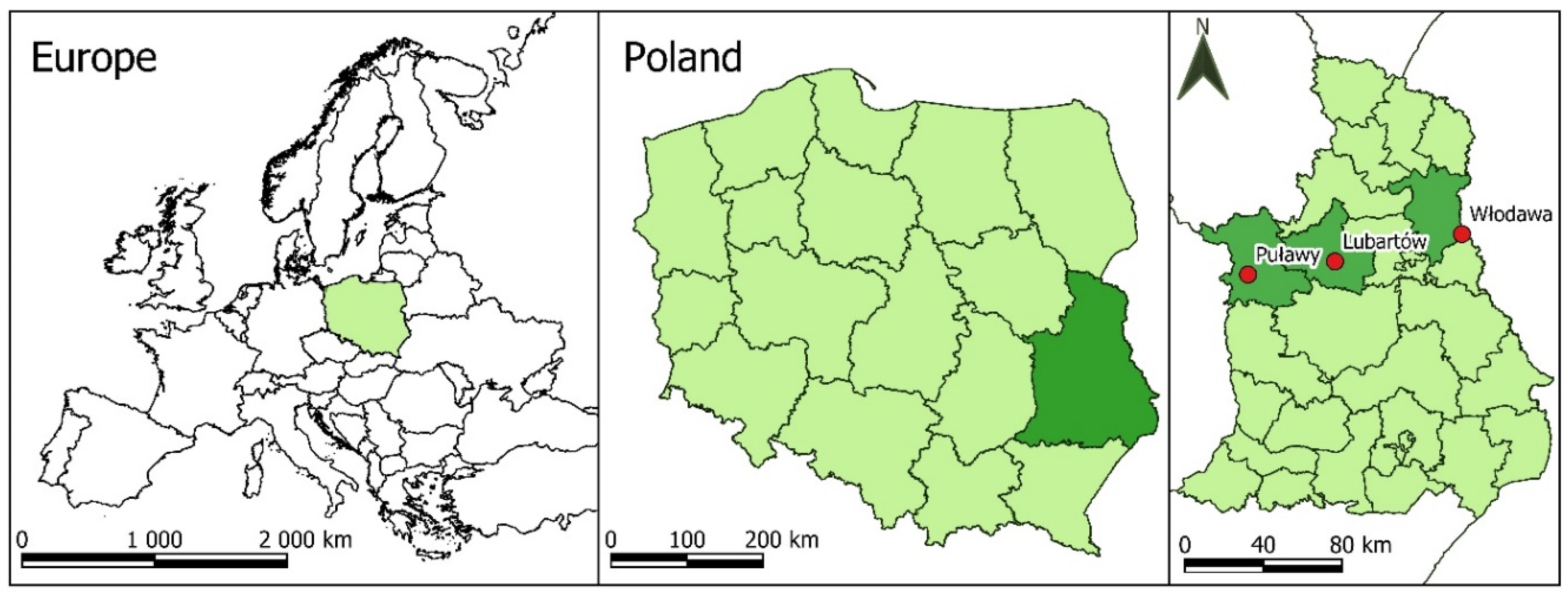


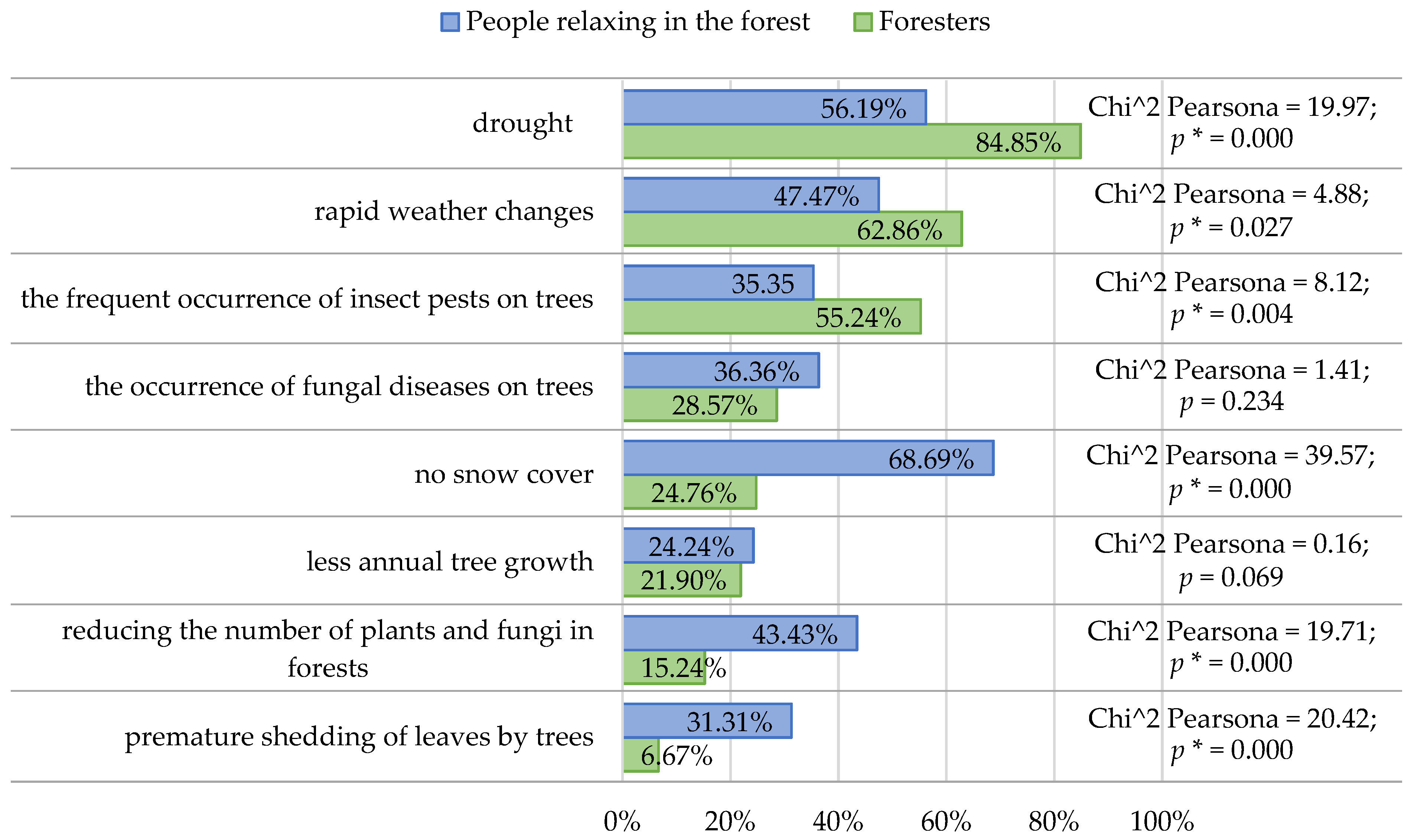

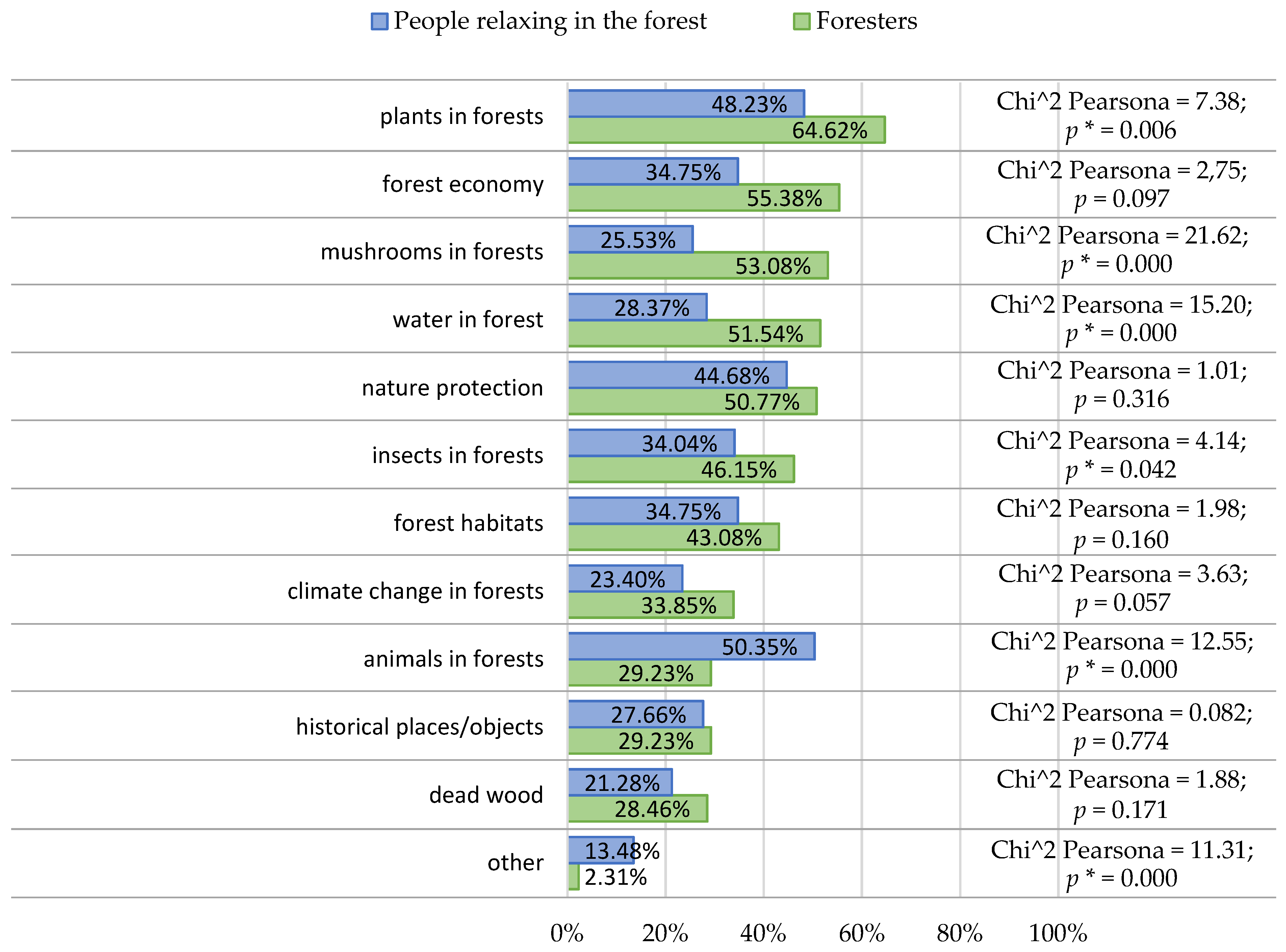
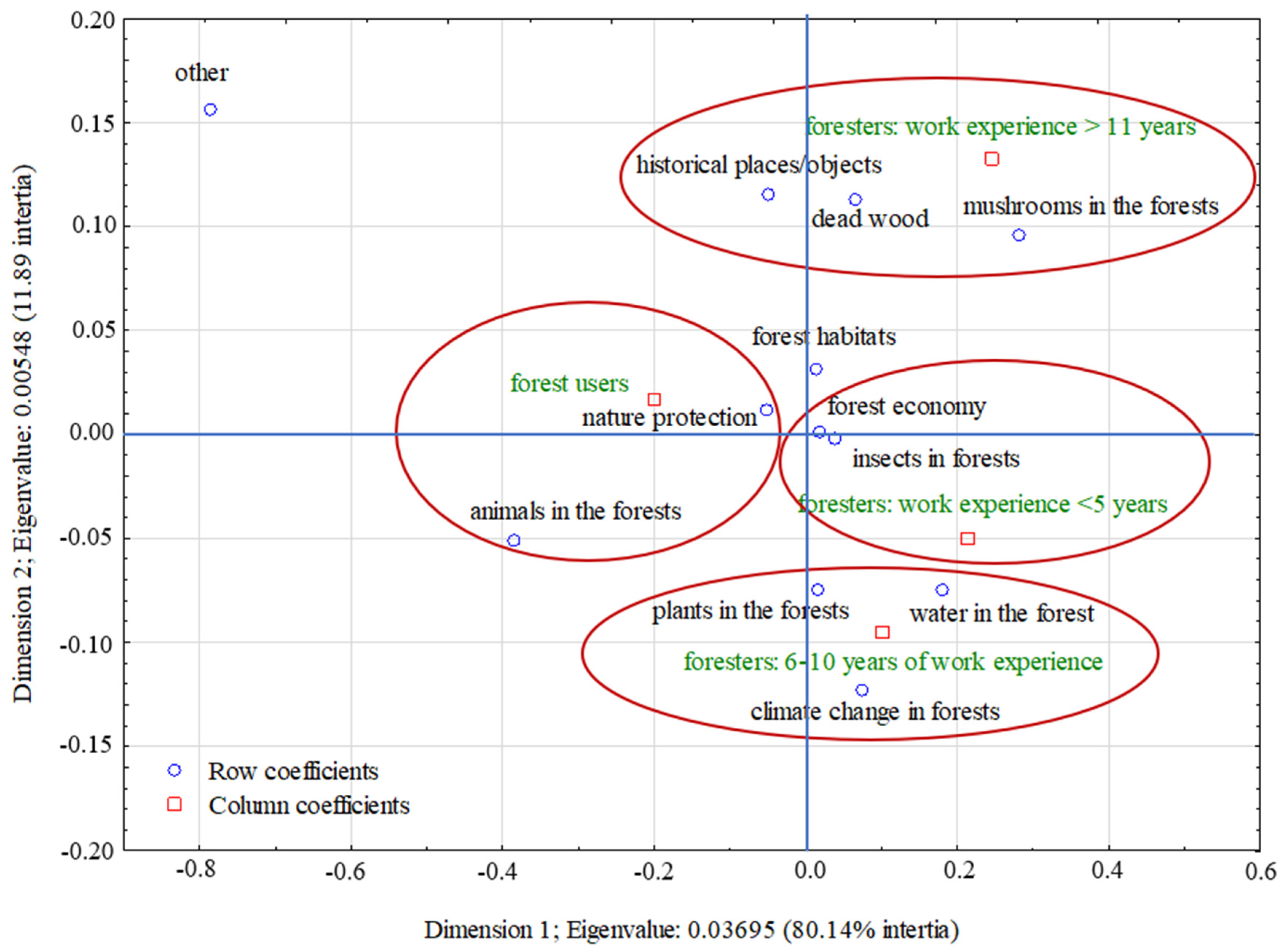

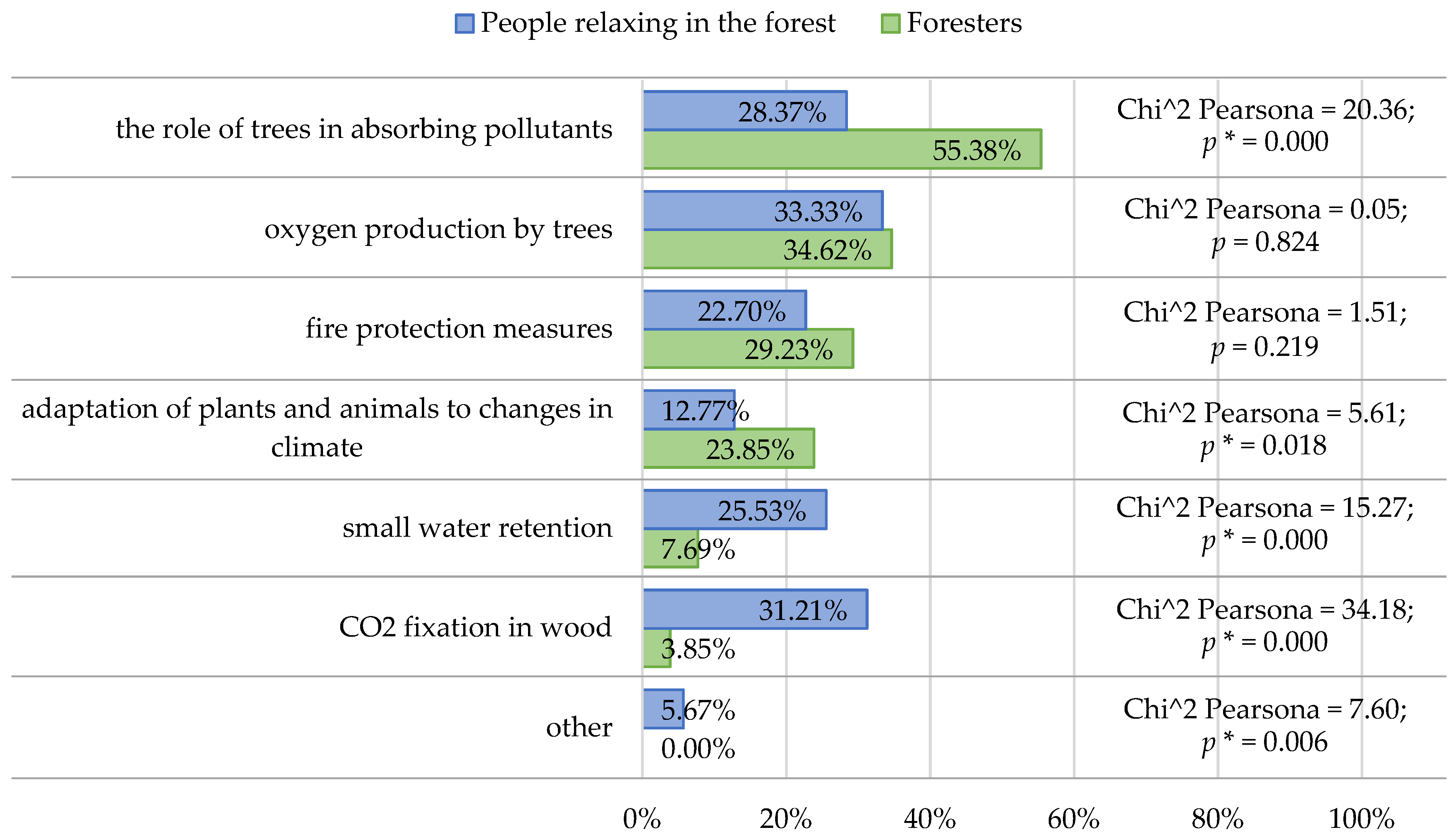

| Forest Districts | Surface Area | Forest Cover | Forest Habitats ** | Dominant Species Composition *** | Average Age of Forest Stands | ||
|---|---|---|---|---|---|---|---|
| Forest districts Puławy | 15,862 ha | 22.41% | Fresh coniferous forest | 29.79% | Scots pine Pinus sylvestris L. | 64.35% | 60 years |
| Mixed broad-leaved forest | 22.88% | Sessile oak Quercus petraea (Matt.) Liebl. | 18.08% | ||||
| Broadleaved forest | 19.19% | Black alder Alnus glutinosa (L.) Gaertn. | 5.19% | ||||
| Fresh mixed coniferous forest | 18.61% | Silver birch Betula pendula Roth | 6.38% | ||||
| Common hornbeam Carpinus betulus L. | 3.75% | ||||||
| Forest districts Lubartów | 13,436.18 ha | 22.15% | Mixed broad-leaved forest | 52.37% | Scots pine Pinus sylvestris L. | 77.78% | 72 years |
| Fresh mixed coniferous forest | 15.68% | Pedunculate oak Quercus robur L. | 13.14% | ||||
| Broadleaved forest | 10.33% | Silver birch Betula pendula Roth | 2.96% | ||||
| Fresh coniferous forest | 7.90% | Black alder Alnus glutinosa (L.) Gaertn. | 3.55% | ||||
| Forest districts Włodawa | 22,758.62 | 28.8% | Mixed broad-leaved forest | 38.57% | Scots pine Pinus sylvestris L. | 63.24% | 62 years |
| Moist mixed broadleaved forest | 17.44% | Silver birch Betula pendula Roth | 12.56% | ||||
| Fresh mixed coniferous forest | 16.06% | Black alder Alnus glutinosa (L.) Gaertn. | 11.73% | ||||
| Moist mixed coniferous forest | 8.06% | Pedunculate oak Pedunculate oak Quercus robur L. | 10.23% | ||||
| Foresters | People Relaxing in the Forest | |
|---|---|---|
| [%] | [%] | |
| Gender | ||
| Female | 40.77 | 69.86 |
| Male | 59.23 | 30.14 |
| Age | ||
| 18–29 | 19.23 | 1.37 |
| 30–39 | 45.38 | 74.66 |
| 40–49 | 35.38 | 10.96 |
| >50 | - | 13.01 |
| Educational level | ||
| Primary education | - | 4.11 |
| High school | 45.38 | 50.68 |
| University | 54.62 | 45.21 |
| Place of residences | ||
| <1 thousand inhabitants | - | 24.66 |
| 1–10 thousand inhabitants | 43.08 | 35.62 |
| 10–100 thousand inhabitants | 56.92 | 17.12 |
| >100,000 inhabitants | - | 22.60 |
Publisher’s Note: MDPI stays neutral with regard to jurisdictional claims in published maps and institutional affiliations. |
© 2021 by the authors. Licensee MDPI, Basel, Switzerland. This article is an open access article distributed under the terms and conditions of the Creative Commons Attribution (CC BY) license (https://creativecommons.org/licenses/by/4.0/).
Share and Cite
Korcz, N.; Koba, J.; Kobyłka, A.; Janeczko, E.; Gmitrowicz-Iwan, J. Climate Change and Informal Education in the Opinion of Forest Users in Poland. Sustainability 2021, 13, 7892. https://doi.org/10.3390/su13147892
Korcz N, Koba J, Kobyłka A, Janeczko E, Gmitrowicz-Iwan J. Climate Change and Informal Education in the Opinion of Forest Users in Poland. Sustainability. 2021; 13(14):7892. https://doi.org/10.3390/su13147892
Chicago/Turabian StyleKorcz, Natalia, Jacek Koba, Agata Kobyłka, Emilia Janeczko, and Joanna Gmitrowicz-Iwan. 2021. "Climate Change and Informal Education in the Opinion of Forest Users in Poland" Sustainability 13, no. 14: 7892. https://doi.org/10.3390/su13147892
APA StyleKorcz, N., Koba, J., Kobyłka, A., Janeczko, E., & Gmitrowicz-Iwan, J. (2021). Climate Change and Informal Education in the Opinion of Forest Users in Poland. Sustainability, 13(14), 7892. https://doi.org/10.3390/su13147892










